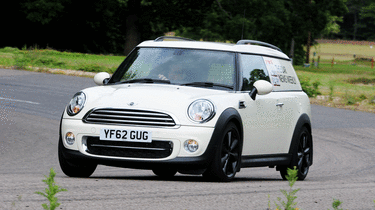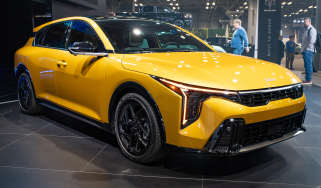MINI Clubvan
New model brings upmarket appeal to commercials market
You can’t help but love the Clubvan. It shares the upmarket cabin and fun driving experience of other models in the range, and the practical cargo area means this MINI can work for a living. It’s also perfect for businesses that want to get noticed. Yet it can’t match the Fiesta for practicality.
The original Mini van went on sale in 1960, and by the time production stopped in 1982, more than half a million had rolled off the factory line.
It’s no surprise, then, that BMW has seized on this as another area of Mini heritage to capitalise on via a modern reinterpretation. The new Clubvan is based on the Clubman estate and has identical exterior dimensions. It also retains the unique rear-hinged extra Clubdoor on the right-hand side. Aside from the blocked-out rear side windows, in fact, it looks identical to the Clubman.
Body-coloured mirrors, roof rails and 15-inch alloys are standard, while £1,130 optional 17-inch black alloys help our car stand out even more. So does the £975 Pepper pack, which includes front foglights. But there are only three paint colours to choose from – the Ford has a much wider palette.
Jump into the driver’s seat and you’ll see the interior is identical to the Clubman’s, with all the retro charm, quality switchgear and upmarket feel of any MINI. So it’s immediately clear that the brand’s first modern-day foray into commercial vehicles hasn’t seen a reduction in quality or character.
Used - available now

2022 Nissan
Micra
22,169 milesManualPetrol1.0L
Cash £10,700
2015 Volvo
S60
78,200 milesManualPetrol1.6L
Cash £7,400
2016 Tesla
Model S
78,000 milesAutomaticElectric
Cash £18,999
2019 Nissan
Micra
17,450 milesAutomaticPetrol1.0L
Cash £13,199Standard kit includes a DAB radio, air-con and electric mirrors, and those used to the workmanlike interiors of most vans will be impressed with the extra glamour of our car’s £920 leather seats, £110 chrome detailing pack and standard piano black trim inserts.
From the inside, the Clubvan feels nothing like a commercial vehicle, until you look in the mirror and see the fixed mesh bulkhead. Behind this, there’s a decent 860-litre load bay, but the metal frame eats into space, meaning total volume is actually 130 litres down on the Clubman’s. Still, the flat floor and sides make it more useful than the awkwardly shaped boots in the Clubman and the Fiesta Van.
The twin rear doors are well suited to the van, while a tailored rubber mat ensures the boot floor is able to cope with a hard life and can be hosed down. There are also two 12V power sockets, while the tinted rear windows keep prying eyes away from your goods. Mesh grilles behind the glass are a further deterrent.
The extra rear-hinged door behind the driver is reasonably useful, but the intrusive metal cage behind the front seat limits it – only small items can be squeezed through this gap and into the load bay.
More importantly, the height-adjustable driver’s seat is supportive and delivers a sportier seating position than in most vans. This is just as well, as the Clubvan drives with the keenness of any other MINI.
The electric steering is weighty and there’s plenty of feel, while excellent body control and strong grip mean there’s lots of fun to be had. Better still, with 65Nm more torque than the Fiesta, the 270Nm Cooper D – the only diesel version of the Clubvan – is noticeably quicker.
At the track, it managed to sprint from 0-60mph two seconds faster, in 9.9 seconds. More importantly, you can feel the punchier in-gear response – something that will come in handy if you load the MINI close to its 500kg maximum cargo capacity.
Refinement isn’t bad, either. There’s a bit more road noise than in a conventional Clubman, and with big wheels fitted, the ride is a little firm. Yet most of the time, the Clubvan drives so well it’s easy to forget it’s a van.
However, it’s worth noting a couple of potential pitfalls if you’re considering a Clubvan as alternative personal transport. For instance, a lot of council recycling centres don’t allow vans, and you can only pay the VAT-exempt price if you’re VAT registered. Plus, while flat-rate van VED means the 103g/km MINI costs the same in road tax as the 87g/km Fiesta, even with stop-start the Clubvan couldn’t match the Ford’s fuel economy – it averaged 50.7mpg on our test compared with the ECOnetic’s 55.1mpg.
Nevertheless, the newcomer is a fun and worthy addition to the line-up and, unlike some recent models, it sticks closely to the spirit of its classic sixties predecessor. And for businesses looking to make an impact out on the road, the MINI’s head-turning style is sure to be a big bonus.







